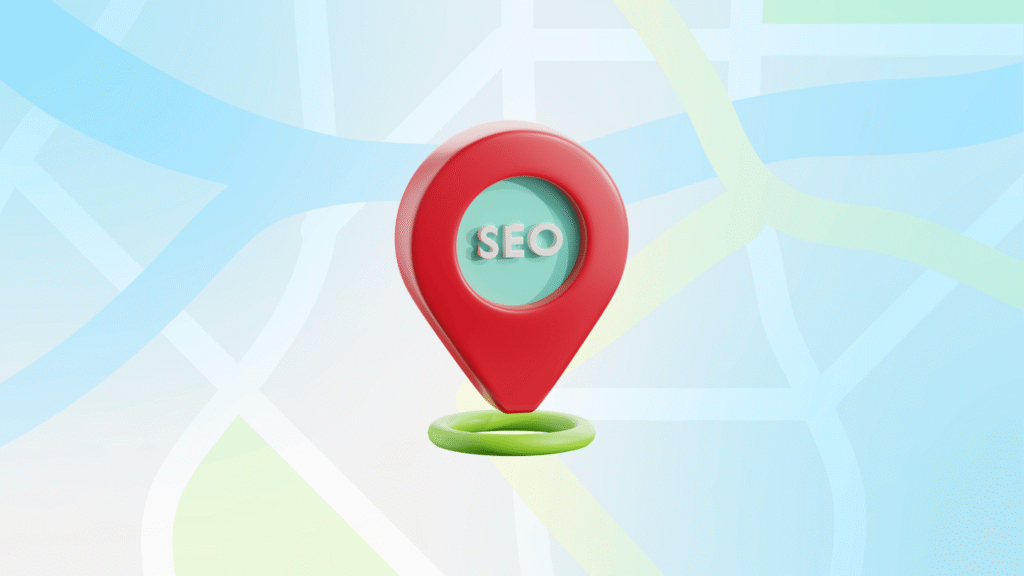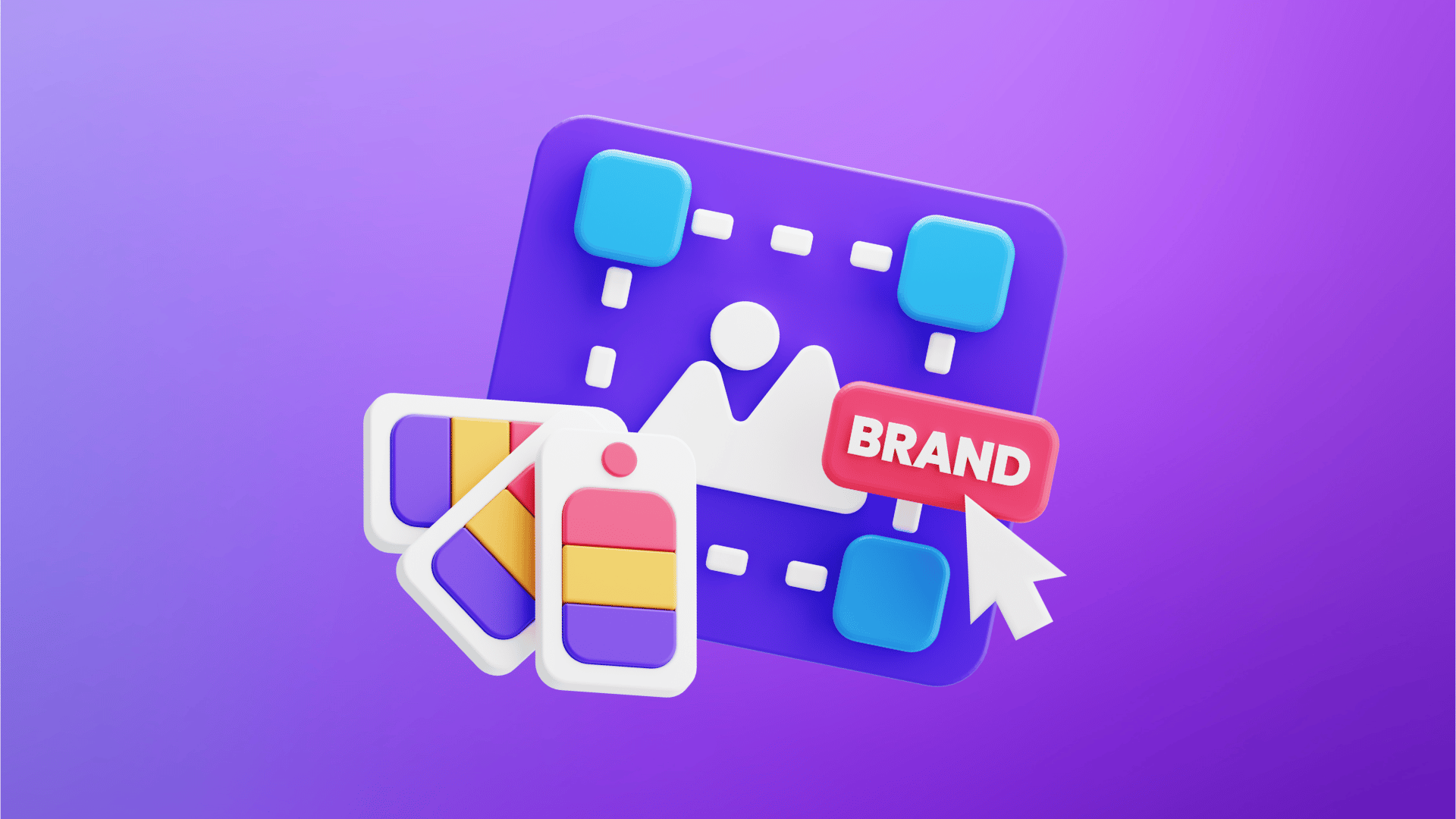Want to know how local SEO could bring billions of potential customers right to your doorstep? Google sends billions of local search results monthly that connect nearby customers directly to businesses like yours.
The numbers might surprise you. About 76% of people who do a local search visit a business within 24 hours. From these searches, 28% lead to a purchase. Your business needs local SEO marketing to survive in today’s digital world.
This detailed local SEO guide targets businesses with physical locations or those serving specific geographic areas – restaurants, dentists, and service providers. Google’s proximity factor helps you appear in search results even when customers don’t include your location in their search. The key lies in implementing local SEO correctly.
Mobile internet access has exploded. People search for local businesses more than ever while they’re on the move. We created this step-by-step resource to show you local SEO’s importance to your business growth strategy. You’ll learn how local SEO works behind the scenes, including Google’s three main ranking factors: relevance, distance, and prominence.
This guide will help boost your local rankings today, whether you’re new to SEO or want to improve your current strategy.
What is Local SEO and Why It Matters
Local SEO helps businesses boost their online presence in specific geographic areas. Your business can connect with nearby customers right when they search for your products or services, unlike traditional online marketing.
Definition and purpose of local SEO
Local SEO optimises your business’s online presence to show up more in location-based search results. This helps your business appear at the top when local customers search for relevant products or services. This specialised search engine optimisation focuses on improving rankings in unpaid, location-based search results on Google Search, Google Maps, and other search engines.
The goal connects your online presence with your physical store or office. Research shows that 80% of US consumers look up local businesses online every week. On top of that, 76% of people who search locally visit a business within 24 hours, and 28% of these searches lead to a purchase.
How it is different from traditional SEO
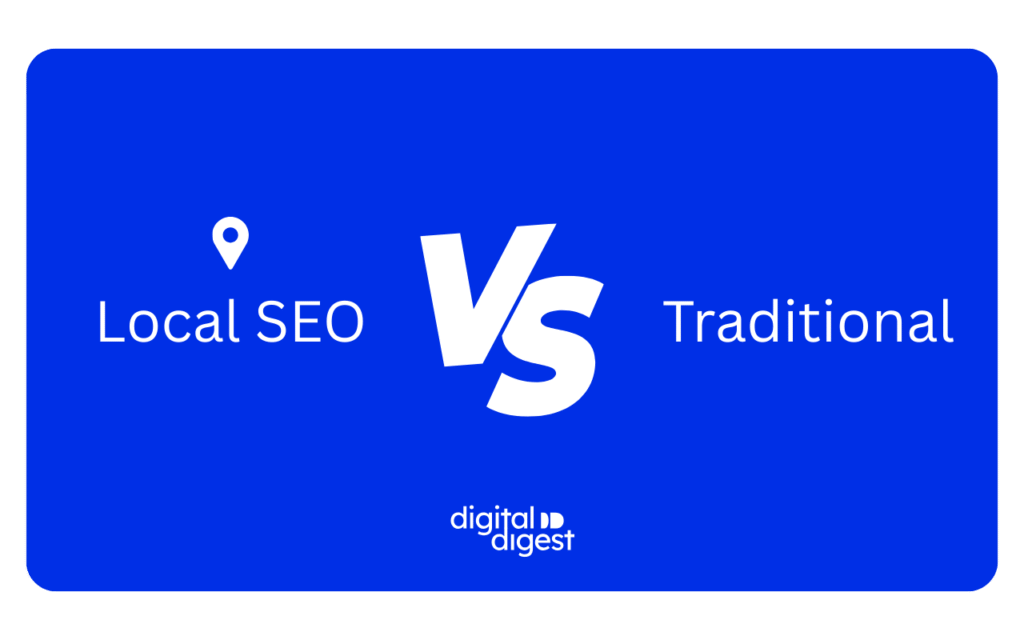
Traditional and local SEO both improve website visibility in search results, but they’re different by a lot in several key ways:
Target audience: Traditional SEO reaches broader audiences, often nationwide or global. Local SEO targets people in specific locations like cities or districts. This focused approach connects businesses with nearby customers who might visit physical locations.
Search intent: Local SEO handles searches with geographic limits, like queries with “near me,” city names, or when Google spots local intent. Since 2017, searches with phrases like “near me today/tonight” have grown by 900%.
Ranking factors: Both share common elements, but local SEO includes location-specific factors. Website content matters, but local SEO also looks at:
- Google Business Profile optimization
- Local citations and business listings
- Review signals from customers
- Location-based information
Who benefits most from local SEO
Local SEO works best for businesses with physical locations or those serving specific areas, especially when you have:
- Retail stores and restaurants
- Professional services (doctors, lawyers, dentists)
- Home services (plumbers, electricians, contractors)
- Local service providers (tutors, dog walkers)
“If a significant portion of your revenue relies on local customers or foot traffic, local SEO is essential,” explains industry expert Strato Doumanis. Almost half of all Google searches now have local intent, creating a huge chance for local businesses.
The advantages go beyond visibility. Local SEO cuts marketing costs by reaching the right audience and using existing online resources instead of expensive ad campaigns. You can also track traffic data from your target area to learn about customer behavior.
Small businesses can compete with larger companies through local SEO affordably. SEO expert Stephen Duetzmann notes, “People who search for businesses and services in their area are much more likely to be looking to buy. This makes being at the top of the search results page very important”.
How Local SEO Works Behind the Scenes
Google’s sophisticated algorithm powers every successful local search result and decides which businesses show up when people look for local services. You need to understand the hidden mechanisms that drive these results to grasp local SEO at a technical level.
Google’s local ranking factors: relevance, distance, prominence
Google uses three main factors to rank businesses in local search results. These factors work together to give users the most suitable results.
Relevance shows how well a local business matches a search query. Google looks at:
- Your Google Business Profile information and how it lines up with searches
- Business categories and attributes that fit your business
- Website content quality and its local focus
Businesses should provide detailed information in their Google Business Profile. This helps Google understand your business better and match it with the right searches.
Distance looks at how far businesses are from the search location. Google uses what it knows about your current location if you don’t specify one. The results change based on where you search from – try searching for something from different places to see this in action.
Prominence shows how popular a business is both online and in real life. Google tries to show ground popularity in search results. That’s why famous landmarks or 20-year old brands often rank higher. Several things boost prominence:
- Reviews: Higher numbers and better ratings help local ranking
- Citations: Mentions of your business details across the web
- Backlinks: Quality website links show authority
- Website SEO: Organic web rankings affect local results
Local intent drives 46% of all Google searches. This adds up to billions of local searches each day.
Understanding the local pack vs organic results
Google shows two different types of results when you search for local businesses: the local pack and organic results.
The local pack sits at the top of search results. It shows three local businesses with a map. This prime spot gets 44% of clicks on Google’s results page. You’ll see:
- Business name and logo
- Star ratings and review count
- Address and phone number
- Business hours
- Website and directions links
Here’s an example;
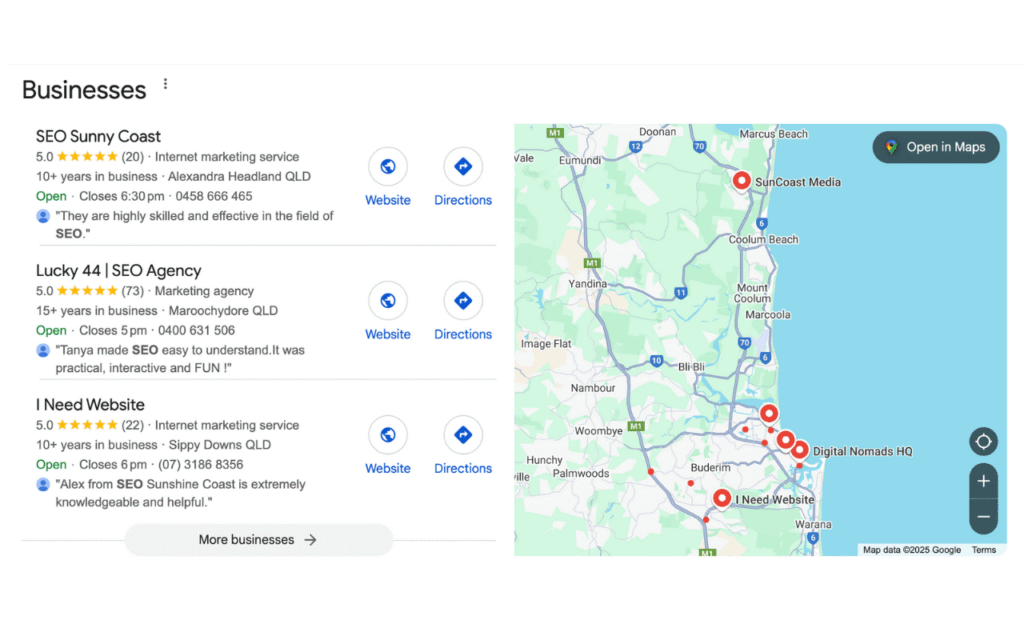
Organic results appear below the local pack. They include:
- Business name
- Page title as a blue hyperlink
- Meta description or relevant text snippet
- Extra site links sometimes
Like this;
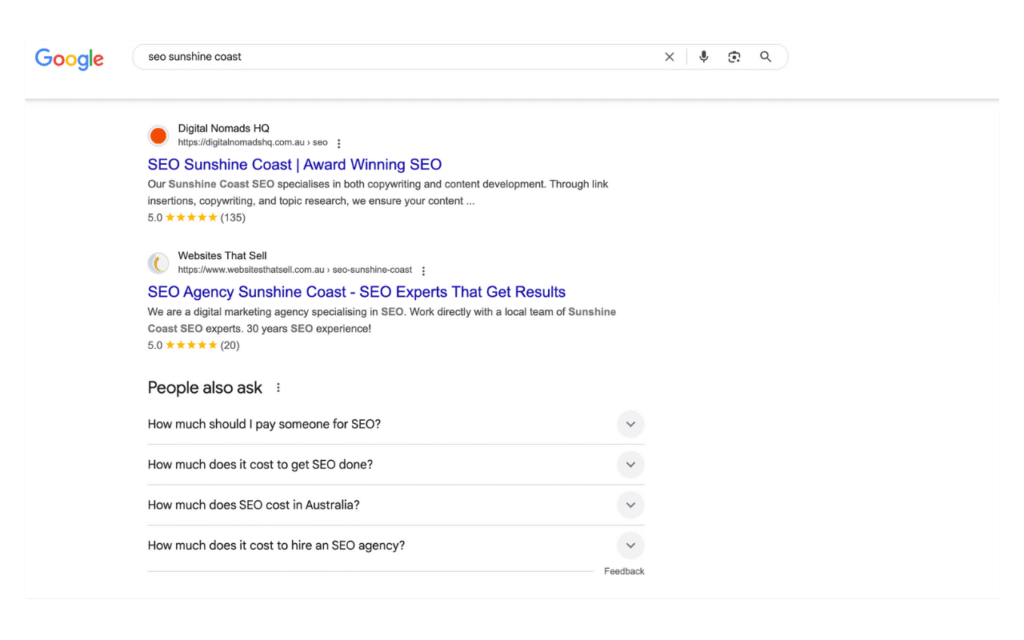
Your Google Business Profile optimization mainly affects local pack rankings. Traditional SEO factors like content quality, backlinks, and technical optimization drive organic results more.
Good rankings in one area can affect your position in the other. Google’s “Diversity Update” suggests that dominating local pack rankings might change your organic rankings.
Both result types hold valuable spots on Google’s first page. A complete local SEO strategy should target both areas since they need different but related approaches. Businesses can capture more local search traffic by understanding these background mechanisms.
Step-by-Step Local SEO Setup
A strong local SEO strategy needs five key elements to succeed. By doing this, you’ll build a powerful local presence that brings nearby customers to you when they search for your products or services.
1. Claim and optimise your Google Business Profile
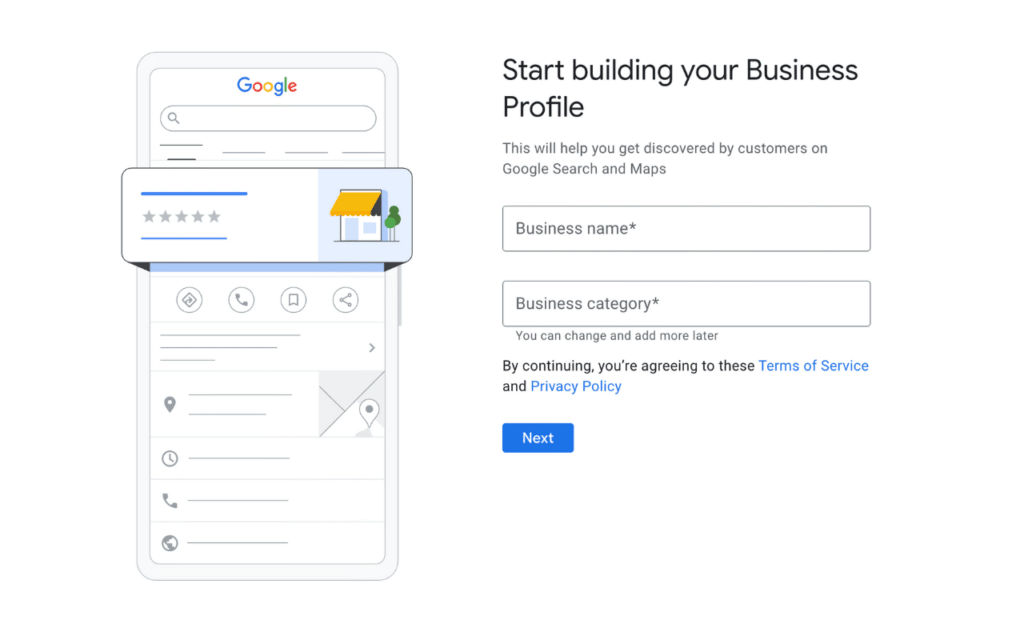
Google Business Profile (GBP) ranks as the top factor for local pack results, and it forms the foundations of any local SEO strategy. Start by claiming your profile through Google Maps and verify your ownership. Next, add all your business details including your exact business name (without keyword stuffing), phone number, and address.
Studies show that businesses with photos get 35% more clicks, and 86% of customers look up businesses on Google Maps. Your primary business category needs careful selection. You should also add relevant secondary categories to show up in more local searches. Keep your business hours up to date since wrong information makes customers lose trust.
2. Ensure NAP consistency across platforms
NAP (Name, Address, Phone number) consistency signals trust to search engines and customers alike. In fact, inconsistent NAP information can hurt your local search rankings. Google and other search engines check your business details across multiple platforms to confirm they’re legitimate.
Research reveals that 93% of consumers get frustrated by wrong information in online directories. About 80% lose faith in businesses that show different contact details. Small formatting differences like “St.” versus “Street” don’t matter much. The core team should focus on keeping similar information everywhere your business appears online.
3. Conduct local keyword research
Start your keyword research with a list of your solutions and locations. You can employ tools like Semrush’s Keyword Magic Tool to find terms with local intent. Then assess metrics like search volume and difficulty for your specific location.
These keywords should go into your Google Business Profile description. This helps match your listing with relevant searches. Your keyword research also helps pick the right business categories for your GBP, which plays a big role in local rankings.
4. Build local citations
Local citations mention your business information across the internet. You’ll find these citations in directories like Yellow Pages, social platforms, review sites, and local blogs. Citation signals rank sixth in importance for both local pack and organic search results.
Your citations need to stay consistent—each listing should show the same information. Businesses with multiple locations might want to invest in listing management solutions that spot and fix any differences automatically.
5. Encourage and manage online reviews
Reviews stand as the third most important factor for local pack results. About 77% of consumers read reviews before they buy. A whopping 94% of consumers say bad reviews stop them from visiting a business.
Make sure to respond to all reviews—good and bad. Most customers (53%) want businesses to address negative feedback within a week. The quality, quantity, recency, and variety of reviews affect your local SEO performance. Most customers don’t trust businesses rated below 4 stars. They often filter results to see only highly-rated companies.
Advanced Local SEO Tactics
Your local SEO strategy needs advanced tactics to stand out from competitors after you nail the basics. Search engines will better understand your local relevance through sophisticated approaches that build authority in specific geographic markets.
Create location-specific landing pages
Location-specific landing pages boost local visibility for businesses that serve multiple areas. Research indicates these pages capture organic search traffic in specific geographic areas by targeting local keyword variations. Your pages should have at least 40-60% unique content instead of generic templates to avoid duplicate content penalties.
A powerful location page should have:
- Content that speaks to unique characteristics of each target location
- Reviews and testimonials from happy customers in that area
- References to local landmarks, events, or organizations with relevant links
- Area-specific calls-to-action that guide visitors toward next steps
Research shows these well-laid-out location pages help customers find their nearest location. They also tell search engines about each location’s unique traits, which improves visibility in organic results and the Google 3-Pack.
Use schema markup for local businesses
Schema markup gives search engines structured data about your business to improve search result appearance. LocalBusiness schema helps search engines understand essential details like your address, business hours, and services.
Local business schema, when implemented correctly, will:
- Boost your visibility in rich snippets and local search results
- Give search engines specific details like your NAP, business hours, and geolocation
- Show Google your business authority in your region and industry
JSON-LD format works best for implementation (Google recommends it). Make sure to include required properties like @id, address, and name. Add recommended elements such as business type, phone number, and geolocation coordinates.
Build local backlinks through partnerships and PR
Google sees local backlinks as trust signals from other local entities. These mutually beneficial alliances strengthen your brand’s community presence beyond improving search rankings.
Try these proven tactics:
- Team up with complementary local businesses on content or events – a tax lawyer could work with a bookkeeping service on a tax tips newsletter
- Support community events, sports teams, or local charities that often link back in their promotional materials
- Connect with local influencers who create authentic content about your business
- Join local business associations or chambers of commerce that provide member listings with valuable backlinks
These local partnerships offer more than SEO benefits – they show your business actively contributes to the community.
Tools to Help You Succeed with Local SEO
You need the right set of tools to make your local SEO strategies work. These specialized solutions help you track performance, manage your online presence and spot areas where you can do better.
Google Business Profile Manager
This free tool, previously called Google My Business, is the life-blood of any local SEO strategy. Your business visibility on Google Maps and Search improves when you manage how it appears. The platform lets you keep business information accurate, connect with customers through reviews and posts, and bring in new customers. Businesses that complete their profiles are 2.7 times more likely to look trustworthy and attract 70% more visits from potential customers.
Semrush Listing Management
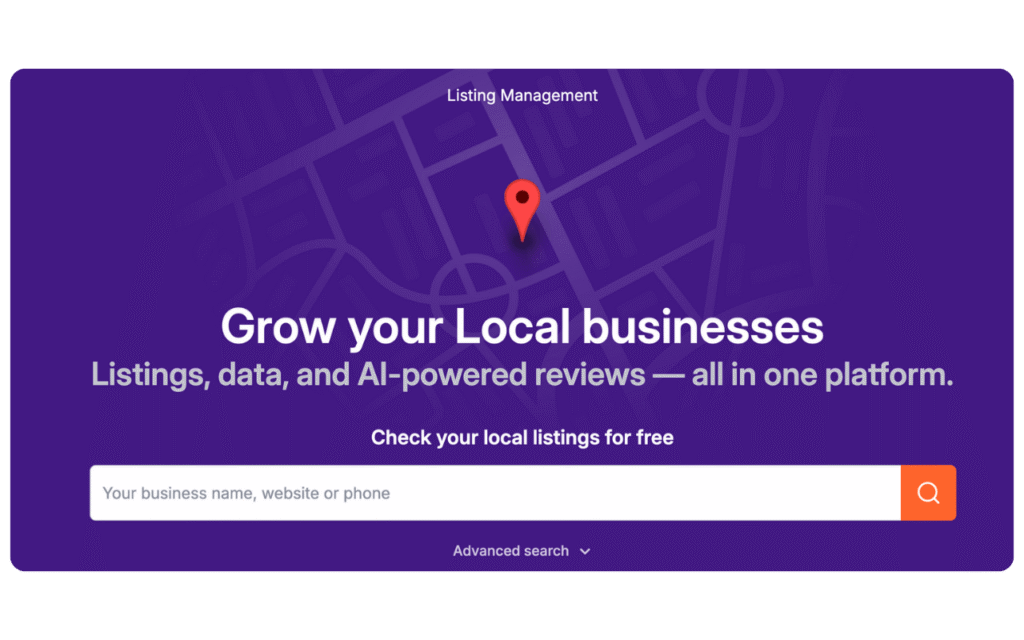
This robust tool spreads and maintains your business information across key directories automatically. Your Name, Address, and Phone number (NAP) stay consistent throughout the web. The tool connects with over 100 unique directories worldwide and locally. Your local SEO visibility and online credibility grow together. Duplicate listings that could hurt your local rankings get suppressed too.
Google Search Console
Search Console plays a vital role in local SEO monitoring and shows exactly how your site performs in search results. You can track impressions, clicks, and position on Google Search, including local pack traffic. The tool lets you submit sitemaps and individual URLs for crawling while alerting you about site problems. Local results activity shows up in reports, though it mixes with traditional organic results.
Review management tools
Reviews affect local rankings by a lot, so dedicated management solutions help you watch all platforms in one place. ReviewTrackers, Podium, and BrightLocal offer features to watch new reviews, give quick responses, and spot patterns. Evidence shows that good review management ranks among the best ways to boost local SEO rankings. Google sees positive reviews as a sign that you serve your community well.
Local rank tracking tools
These specialized tools show how your business ranks in specific areas. BrightLocal’s Local Search Grid, Local Falcon, and Semrush’s Map Rank Tracker use colored map pins to show rankings across locations. Rankings change based on distance—businesses usually rank better near their physical location than they do a few blocks away.
Conclusion
Local SEO is a powerful tool that helps businesses connect with nearby customers who actively search for their products or services. This piece explores what local SEO is, why it matters, and how to make it work. You now understand Google’s three key ranking factors: relevance, distance, and prominence. These factors determine your local search visibility.
Keep in mind that 76% of people who complete a local search visit a business within 24 hours. Your digital marketing strategy must include optimizing your Google Business Profile, maintaining NAP consistency, researching local keywords, building citations, and managing reviews.
On top of that, it helps to create location-specific landing pages, implement schema markup, and build local backlinks to raise your local presence above competitors. The right tools make all the difference – from Google Business Profile Manager to specialized rank tracking solutions. These help you monitor performance and spot opportunities to improve.
Local SEO success takes time. All the same, businesses that stick to these strategies see gradual improvements in visibility, foot traffic, and end up increasing revenue. The local search world keeps changing, but these fundamental principles stay stable.
Put these practices to work today. Track your results and adjust your approach based on what the data shows. Without doubt, your efforts will pay off as more nearby customers find your business right when they need your services most.
FAQs
Q1. What is local SEO and why is it important for businesses? Local SEO is a strategy that helps businesses improve their visibility in location-based search results. It’s crucial because it connects local customers with nearby businesses, potentially leading to increased foot traffic and sales. With 76% of local searchers visiting a business within 24 hours, local SEO can significantly impact a company’s bottom line.
Q2. How does local SEO differ from traditional SEO? While both aim to improve search visibility, local SEO focuses on specific geographic areas and incorporates location-specific factors. It targets searches with local intent, optimizes for Google’s local pack, and considers elements like Google Business Profile, local citations, and customer reviews, which are less emphasized in traditional SEO.
Q3. What are the key factors that influence local search rankings? Google primarily considers three factors for local rankings: relevance (how well a business matches the search query), distance (proximity to the searcher), and prominence (the business’s overall reputation and visibility online and offline). Optimizing for these factors can significantly improve local search performance.
Q4. How can businesses improve their local SEO? To enhance local SEO, businesses should optimize their Google Business Profile, ensure NAP (Name, Address, Phone number) consistency across online platforms, conduct local keyword research, build local citations, and actively manage online reviews. Advanced tactics include creating location-specific landing pages and implementing schema markup for local businesses.
Q5. What tools can help with local SEO efforts? Several tools can assist with local SEO, including Google Business Profile Manager for managing your business listing, Semrush Listing Management for maintaining consistent business information across directories, Google Search Console for monitoring search performance, review management tools for handling customer feedback, and local rank tracking tools for visualizing rankings across different locations.
Author
-

Managing Director of one of Australia's leading Digital Marketing Agencies... With over 5+ years of hands on experience in SEO, managing both national & international organisations SEO strategy and campaign distribution. Having won several international awards (Search Awards, Clutch, TechBehemoth etc.) for both paid media and search campaign success... He is a front runner in leading search and defining the playbook for the Australian market.
View all posts
